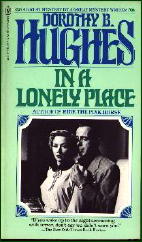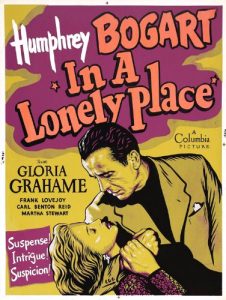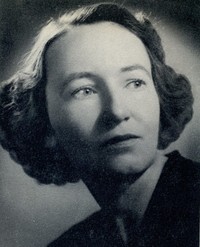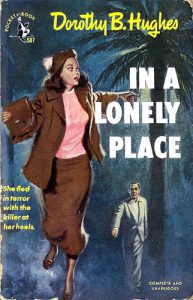In a Lonely Place is one of Dorothy B. Hughes’ most popular hardboiled mystery novels. Known for her ability to create terror within the pages of her novels, In a Lonely Place does not disappoint 3. Hughes is known for writing characters who are outsiders, who do not quite fit into their surroundings or seemingly their own lives, and this novel is no different. It is set in Los Angeles post WWII and centers around Dix Steele, an ex airman who enjoys wandering the streets of LA at night, at a time when a woman hating serial killer is on the loose. One of the most fascinating things about this book comes with the knowledge that Hughes portrays a serial killer before the term was even coined4. Dix reconnects with an old war buddy, Brub Nicolai, who is one of the main detectives on the case. The novel follows Dix’s everyday life and his curious interactions with Brub, his wife Sylvia, and Dix’s obsession, an actress named Laurel Grey. Dix is deeply fascinated with the murders and pries Brub for details under the guise of looking for inspiration for a mystery novel he says he is writing.
The point of view of this novel is something to be acknowledged. The reader gets a third person narrative, but told from Dix’s perspective. It is certainly not a common way to read a mystery novel. The main character is not a police officer or even a private detective, merely a man fascinated with the case of the murdered women. Dix is connected to the detective,but the detective is not in every scene. Dix’s life is more than the case and we are able to see things that happen unrelated to the murders, though we are never far from the creeping feeling that one gets knowing a fictional serial killer is on the loose. Dix’s character slowly unravels throughout the book and I for one became more and more uneasy with his growing apparent instability.
This novel can be applauded for its feminist writing. Traditional hardboiled novels are all violence and macho demeanor. Women rarely feature in these books and when they do they are usually in the role of the virgin or the whore. While the main character of this book is a man, the women play an important role in the story. From the outset of the novel Dix is uncomfortable with Brub’s wife, Sylvia. He can feel her perceptiveness and is made nervous by the feeling that she can see through him, to the parts he does not want to share. Dix also shares a rather intense relationship with a woman living in his building, an actress named Laurel Grey. She too seems to be able to see through him as well as have a power over him. Often in mystery novels when women have power over men they are written as the femme fatale, a dangerous and selfish woman who cannot be resisted. While Dix cannot resist Laurel, she does not fit into the femme fatale role. She is not a power hungry woman just using him to get what she wants. I found her character very relatable when she and Dix first met. She carried herself with a confidence but in all other ways acted like a normal woman going out on a date with a new man. Having relatable and intelligent women in a mystery novel is very refreshing, especially to female readers.
In a Lonely Place is feminist not only for its portrayal of women as strong independent characters, but also in the way that it tackled masculinity. Toxic masculinity can be seen in the book through the serial killer. This is a man who preys on women in vulnerable dark places which is clearly a play for power. Dix seems to have a fear and hatred of women. His fear of Sylvia clearly comes from the fact that he believes she can see through him. That destroys his feeling of masculinity because he no longer feels mysterious and powerful if a mere woman can see through to his true self. Hughes writes a terrifying, woman hating, serial killer that addresses all of the toxic masculinity seen by women every day and brings it to life in a horrifying way.
In a Lonely Place was adapted into a 1950 movie starring Humphrey Bogart. The plot of the movie diverges from the book in many major ways, including the portrayal of Dix Steele. The movie was widely successful but I believe that since it does not follow the most important part of the book it shouldn’t be considered a good adaptation. The book was also adapted into a radio show in 1952.
Overall I highly enjoyed In a Lonely Place. It was one of the most exciting books I have read in a while. Knowing it was one of the first portrayals of a serial killer make it even more interesting to me, and I know I am not the only one who has a morbid fascination of sociopathic serial killers. This book has a definitively creepy element. While I enjoyed reading it, sometimes I had a hard time cracking it open while nestled in bed with my dog because I have to say it is impossible to be relaxed while reading something so unsettling. The disturbing element of the book is part of what makes it so great, but can also make it hard to read at times. I would not recommend this to someone who gets easily overwhelmed by creepy books and movies, but if you can get past the discomfort it is certainly a book worth reading.
References
- “Hughes, Dorothy B.” Gadetection / Hughes, Dorothy B, gadetection.pbworks.com/w page/7930803/Hughes%2C%20Dorothy%20B.
- “In a Lonely Place (Novel).” Wikipedia, Wikimedia Foundation, 12 Nov. 2017, en.wikipedia.org/wiki/In_a_Lonely_Place_(novel).
- Smallwood, Christine. “The Crime of Blackness: Dorothy B. Hughes’s Forgotten Noir.” The New Yorker, The New Yorker, 18 June 2017, www.newyorker.com/books/ page-turner/the-crime-of-blackness-dorothy-b-hughess-forgotten-noir.
- Weinman, Sarah. “On the World’s Finest Female Noir Writer, Dorothy B. Hughes.” LosAngeles Review of Books, lareviewofbooks.org/article/on-the-worlds-finest- female-noir-writer-dorothy-b-hughes/#!




